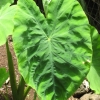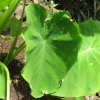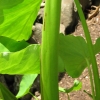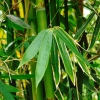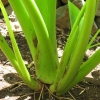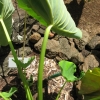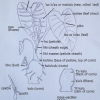Use As Food
Makes poi of excellent quality.
Distribution
Very common in Kona, Puna, and Ka‘ū on Hawai‘i, primarily under upland culture (māla).
General Characteristics
Medium in height, well spreading, stocky, maturing within 12 to 16 months, producing from 5 to 10 ‘ohā; characterized by light green Hā (Petiole) with light reddish-brown tinge on lower half.
Ha (Petiole)
60 to 80 cm. long, light green tinged with light reddish-brown on lower half, with inconspicuous, narrow, reddish-brown edge, an orange-red or dark pink ring at the kōhina (base) with light greenish or pinkish area for 3 to 5 cm. above the base.
Lau or Lu'au(Leaf Blade)
35 to 45 cm. long, 20 to 30 cm. wide, 30 to 35 cm. from tip to base of sinus (māwae), arrow head shaped, thin in texture, medium green; margins slightly wave-like (undulate); piko whitish to light brownish; round leaf section (lobes) acute with wide lihi māwae (sinus).
'I'o kalo (Corm)
Flesh white with light pinkish tinge, especially near the top (apex), and yellowish fibers; skin light pink.
Pua (Flower)
Remarks
This variety is an important māla (upland) poi taro, especially well adapted to elevations above 1,500 feet. This means it does well in cold temperatures. According to Canoeplants.com, Polynesian settlers used the bamboo ‘Ohe for water containers, building material and instruments.

